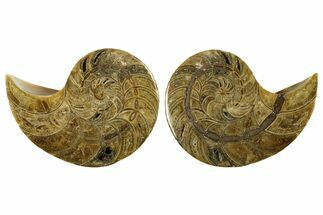This Specimen has been sold.
6.2" Pennsylvanian, Fossil Microbial Mat - Oklahoma
This is a 6.2" wide section of microbial "mat" from the Hartshorne Sandstone of Haskell County, Oklahoma. Also known as "MISS" (Microbially Induced Sedimentary Structures), it's the fossilized ichnofossils left behind by a colony of microbes, similar to the formation of stromatolites.
It comes with a display stand.
It comes with a display stand.
About Stromatolites
Stromatolites are fascinating, ancient rock formations created by the activity of cyanobacteria and other microorganisms. These layered, mound-like structures represent some of the earliest evidence of life on Earth, dating back over 3.5 billion years. Often found in shallow, warm waters, stromatolites form as layers of sediment and minerals are trapped and bound by microbial mats, gradually building up over time into unique, textured shapes.
Visually, stromatolites can range from smooth, rounded forms to intricate, banded structures, with colors that span earthy reds, browns, greens, and grays. Each layer captures a record of environmental conditions at the time of its formation, making stromatolites an invaluable source of information for scientists studying Earth’s early history and the origins of life.
Today, fossilized stromatolites are highly prized by collectors, both for their scientific significance and their natural beauty. Some living stromatolites can still be found in a few rare locations around the world, such as Shark Bay in Australia and certain alkaline lakes.
Stromatolites are fascinating, ancient rock formations created by the activity of cyanobacteria and other microorganisms. These layered, mound-like structures represent some of the earliest evidence of life on Earth, dating back over 3.5 billion years. Often found in shallow, warm waters, stromatolites form as layers of sediment and minerals are trapped and bound by microbial mats, gradually building up over time into unique, textured shapes.
Visually, stromatolites can range from smooth, rounded forms to intricate, banded structures, with colors that span earthy reds, browns, greens, and grays. Each layer captures a record of environmental conditions at the time of its formation, making stromatolites an invaluable source of information for scientists studying Earth’s early history and the origins of life.
Today, fossilized stromatolites are highly prized by collectors, both for their scientific significance and their natural beauty. Some living stromatolites can still be found in a few rare locations around the world, such as Shark Bay in Australia and certain alkaline lakes.
SPECIES
Unidentified
LOCATION
Haskell County, Oklahoma
FORMATION
Hartshorne Sandstone
SIZE
6.2 x 2.95", .65" thick
CATEGORY
ITEM
#301900
We guarantee the authenticity of all of our specimens.
 Reviews
Reviews











